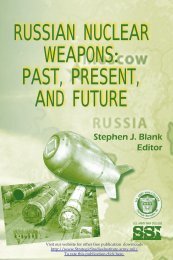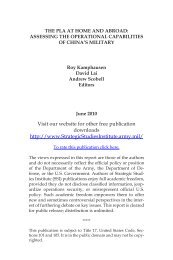The United States and China in Power Transition - Strategic Studies ...
The United States and China in Power Transition - Strategic Studies ...
The United States and China in Power Transition - Strategic Studies ...
You also want an ePaper? Increase the reach of your titles
YUMPU automatically turns print PDFs into web optimized ePapers that Google loves.
Development takes time. Between now <strong>and</strong> then,<br />
Ch<strong>in</strong>ese leaders must f<strong>in</strong>d ways to get the people <strong>in</strong><br />
these two regions engaged <strong>in</strong> the development efforts.<br />
At the same time, the Ch<strong>in</strong>ese government has to deal<br />
with the external forces that are persistently press<strong>in</strong>g<br />
for the separation/<strong>in</strong>dependence of the two regions<br />
from <strong>Ch<strong>in</strong>a</strong>. <strong>The</strong> Ch<strong>in</strong>ese leaders are particularly<br />
concerned with the U.S. factor <strong>in</strong> these two explosive<br />
problems. <strong>The</strong>y hold that the <strong>United</strong> <strong>States</strong> has many<br />
reasons to play these two issues as leverage aga<strong>in</strong>st<br />
<strong>Ch<strong>in</strong>a</strong>; it has the capacity to <strong>in</strong>fluence the course of<br />
the separation/<strong>in</strong>dependence movements; it has been<br />
actively <strong>in</strong>volved <strong>in</strong> the affairs of these two regions;<br />
<strong>and</strong> will cont<strong>in</strong>ue to be so <strong>in</strong> the future.<br />
Tibet, <strong>Ch<strong>in</strong>a</strong>, <strong>and</strong> the <strong>United</strong> <strong>States</strong>. <strong>The</strong> history between<br />
Tibet <strong>and</strong> <strong>Ch<strong>in</strong>a</strong> can be divided <strong>in</strong>to three broad<br />
periods. <strong>The</strong> first goes from mythical or legendary<br />
times to the beg<strong>in</strong>n<strong>in</strong>g of the 7th century when Tibet<br />
emerged as a unified k<strong>in</strong>gdom <strong>in</strong> the Himalaya Mounta<strong>in</strong><br />
region. <strong>The</strong> second period goes from the 630s AD<br />
when Tibet under its found<strong>in</strong>g ruler, Songtsen Gampo<br />
(松赞干布), <strong>and</strong> Tang <strong>Ch<strong>in</strong>a</strong> fought their first of many<br />
wars, through the Mongol-ruled Yuan Dynasty (1271-<br />
1368), the Ch<strong>in</strong>ese restored M<strong>in</strong>g Dynasty (1368-1644),<br />
the Manchu-ruled Q<strong>in</strong>g Dynasty (1644-1911), the Ch<strong>in</strong>ese<br />
ROC (1911-49), to 1950, when Tibet became a formal<br />
part of the PRC, to the present.<br />
<strong>The</strong>re is much controversy <strong>in</strong>volved <strong>in</strong> the presentation<br />
of this long history. Ch<strong>in</strong>ese <strong>and</strong> Tibetans-<strong>in</strong>exile<br />
hold oppos<strong>in</strong>g views. Whereas <strong>Ch<strong>in</strong>a</strong> rout<strong>in</strong>ely<br />
produces its <strong>in</strong>terpretation of this history to legitimize<br />
its rule of Tibet, the Tibetans-<strong>in</strong>-exile make every effort<br />
to dispute <strong>Ch<strong>in</strong>a</strong>’s claims <strong>and</strong> provide their own<br />
versions of this history to justify their struggle for Tibet<br />
<strong>in</strong>dependence. Between these two oppos<strong>in</strong>g forces<br />
155

















